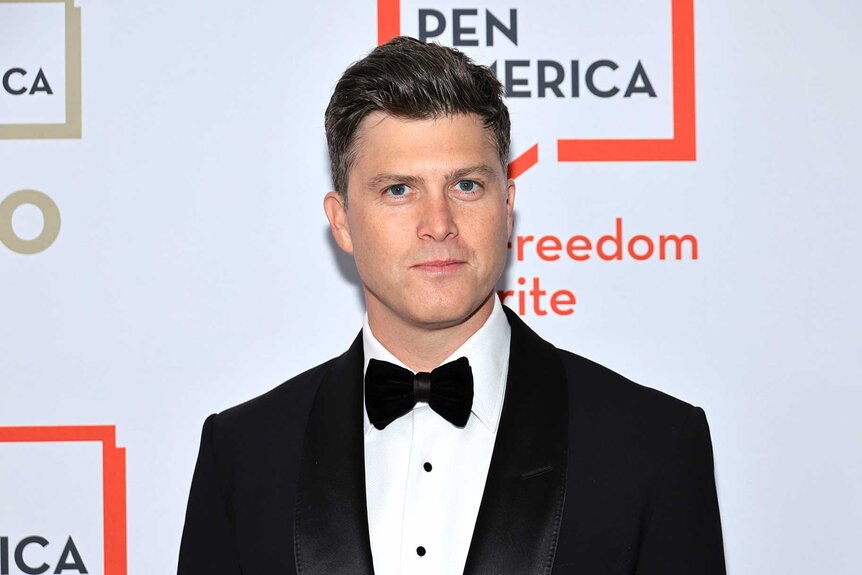SNL Secrets: Colin Jost & The Toupee Tale You Won't Believe It!
Is it possible to maintain a facade, even in the glaring spotlight of live television? The lengths to which some personalities go to preserve their image, particularly in the realm of physical appearance, can be both amusing and revealing.
The world of Saturday Night Live, a crucible of comedy and a breeding ground for celebrity, has long been a hotbed of secrets and stories. One such tale, recounted by Colin Jost in his memoir, highlights the extraordinary lengths a particular host went to in order to conceal a perceived imperfection. The anecdote involves a host, who, rather than simply removing their toupee, insisted that the makeup department apply a bald cap over it, followed by a wig. This incident, shrouded in anonymity, offers a fascinating glimpse into the pressures and insecurities that can plague those in the public eye. It underscores the powerful influence of image and the lengths to which individuals will go to maintain their carefully constructed personas. The very nature of television, a visual medium, amplifies these pressures, making physical appearance a constant focus of scrutiny.
Beyond the anecdote, the discussion often turns to the subject of Colin Jost himself. As a prominent figure on the show, Jost has become a figure of public fascination. Known for his Weekend Update anchor role and his writing, Jost has also gained attention for his personal life, including his relationship with actress Scarlett Johansson. His journey, marked by a sharp wit and a keen understanding of comedic timing, has solidified his place in the comedy landscape. Considering his position, the question of his own appearance and any possible enhancements inevitably arises. The world is curious, and the inquiry into the authenticity of his hair, or any other perceived physical features, can be seen as a reflection of this widespread interest.
This fascination with appearances extends far beyond individual personalities. It is a recurring theme in the world of media, where the pressure to conform to certain standards is immense. The use of wigs, toupees, and various cosmetic procedures has a long history in television, dating back to the earliest days of broadcasting. As long as the news is delivered accurately and professionally, does it really matter if the person on screen is wearing a wig? Wigs have a storied history in television news, a tradition dating back to the early days of broadcast. This is a testament to the industry's constant pursuit of perfection, regardless of the underlying realities.
The incident also brings to mind another prominent figure in the realm of late-night comedy: Pete Davidson. The mention of Davidson, known for his self-deprecating humor and personal revelations, reminds us that even within the industry's world, vulnerability can be a powerful tool. His openness about personal matters often creates a sense of authenticity that resonates with audiences. This contrasts sharply with the host's apparent refusal to acknowledge their situation, highlighting the spectrum of approaches individuals may take in dealing with their perceived flaws.
It is interesting to consider the pressures faced by those who exist on the screen every week. Every commercial break requires a stylist to manage the host's hair to appear just right. It also highlights the demanding nature of live television, where there is little margin for error or any hint of imperfection. For these individuals, maintaining a certain image becomes paramount, and they may go to extraordinary lengths to preserve it.
The story of the SNL host, which is recounted in multiple sources, is a revealing commentary on the role of image in the entertainment industry. Despite the comedic nature of the show and the hosts, there is a serious undertone. The host, as the story goes, went to great lengths to hide the truth about their appearance. The host's actions, in this case, serve as a reminder of the pressures that influence those in the public eye. It is a matter of maintaining a specific public image and the degree of self-awareness that accompanies the process.
The world of "Saturday Night Live" is replete with such anecdotes, showcasing the pressures faced by those who perform. The creative chaos and the intense scrutiny placed upon the cast members contribute to a unique environment. The show's legacy rests on the shoulders of those who deliver the jokes and embody the characters. The show is a testament to the hard work and talent required to entertain and keep the show afloat. As a long-time staple of late-night television, the program continues to shape the comedy landscape and entertain viewers of all generations.
Colin Jost is a prominent figure within this landscape. His contributions to the show are not limited to his role as a Weekend Update anchor. He is a writer and an actor as well. His sharp wit and understanding of comedy have made him a favorite of the show's audience. His work on SNL, the high-profile relationship, and his background all contribute to the interest.
The world of Saturday Night Live is one where the line between the personal and professional often becomes blurred. The public's interest in its stars, their lives, and the behind-the-scenes stories remains an integral part of the show's appeal. It's clear that Jost has not only become a part of SNL's history but a part of the larger cultural story of modern comedy. The anecdote provides a commentary on these complex dynamics and the pressures faced by the people in the public eye.
The story serves as a case study of celebrity image management. The host's choice to conceal his toupee instead of removing it is telling. This incident provides a window into the complex relationship between image and perception in the world of entertainment. The tale of the hair, and the lengths to which the host went to hide the fact that he was wearing a toupee, reminds the reader that appearances can be deceiving.
The discussion about this incident also sparks questions about the industry's own pressures to be picture perfect. The question of whether the individual is authentic becomes important. What is considered "natural"? The incident, taken as a whole, reminds us of the expectations for anyone who is constantly in the public's eye. The emphasis on appearance is more of a reflection of the societal expectations than a value of their talent. The incident has become part of the fabric of entertainment lore.
It's not all about physical traits. The host, the toupee, and the bald cap also bring into focus the work required in order to create this type of show. It is a constant battle against the clock. A commercial break is often a flurry of activity and quick adjustments. Each moment must be perfect, and a small detail can disrupt the entire enterprise. The story, taken as a whole, highlights the pressures of the creative process.
The contrast between the host and the approach of figures like Pete Davidson shows how different approaches can be taken. Honesty can be refreshing. It is a reminder that what appears on the surface is not necessarily the truth. The host, the toupee, and the bald cap incident, serve as a lesson on the complexities of personal image. The episode, in turn, highlights the delicate dance between reality and perception. The willingness to embrace oneself, flaws and all, can be an asset.
In the world of comedy, there are many different types of humor. There are many different avenues for delivering a joke or making a point. The anecdote from the SNL set adds a layer to the show's legacy and contributes to the overall narrative of the celebrity world.
When it comes to appearances, and maintaining a persona, the audience often forgets that those on the screen are human beings. The host's decision to wear the bald cap underscores the power of expectations. The incident is a lesson in perception, reality, and the challenges that come with living in the public eye. The story serves as a reminder that what one sees isn't necessarily the truth.
| Category | Details |
|---|---|
| Full Name | Colin Kelly Jost |
| Date of Birth | June 29, 1982 |
| Place of Birth | Staten Island, New York City, New York, U.S. |
| Education | Harvard University (B.A. History and Literature) |
| Occupation | Comedian, Writer, Actor |
| Known For |
|
| Relationship | Married to Scarlett Johansson |
| Career Highlights |
|
| Notable Works |
|
| Additional Information |
|
| Reference | Wikipedia - Colin Jost |
The narrative is not just about comedy or the use of a toupee, but also about the human condition. The story provides insights into how people deal with self-perception and the pressures of public life. The story is an excellent example of the contrast between the on-screen persona and the reality of human nature.
Beyond the specific example of the host, the story offers a wider look at the world of entertainment and the expectations for public figures. Jost and his fellow comedians are a testament to the value of their audience.
In the face of constant attention, the choice to embrace one's self-image can be a powerful way to show what matters the most. It is a reminder that the best way to deal with pressure is to be real. The anecdote is a valuable reminder of the complexities of the human experience.
The importance of the image, is not the only thing that the audience remembers. What they remember the most is the performance. The host, the toupee, and the bald cap provide an insightful reflection of the entertainment world.
The focus on the host, the toupee, and the bald cap provides a commentary on the pressures of fame and its impact on the individual. It is a story about humor, self-perception, and the role of image in society. The ability to laugh at these details and the situations that they are created in can be a part of the comedic formula.
The story reminds us of the lengths that entertainers will go to in order to preserve their image. The value placed on appearance can be a reflection of the public's own expectations. The SNL host, the toupee, and the bald cap are examples of the high stakes involved in the entertainment industry.
The value of the audience can not be underestimated. The audience's attention is a precious commodity, and the show is a product. The audience's loyalty is what fuels the industry. The host's willingness to put on a bald cap is a small indication of the pressures involved in this industry. The story of the host and the toupee speaks to the importance of how image is preserved. It is a reminder that humor can often be found in the unexpected places.
The host's decision to go to such lengths is a testament to how much the public can influence their personal decisions. The incident underscores the tension between authenticity and the pressure to conform. The story remains a relevant tale of the intersection of performance and the expectations placed on those in the public eye.
The question of whether the person on the screen is wearing a wig is often asked. This is a part of the overall performance. The host and the toupee remind us that what is seen is not always real.


